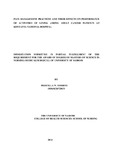| dc.description.abstract | Background: Pain is the most devastating symptoms in cancer and may occur right from time of diagnosis to the end of life. It adversely affects the quality of life especially the physical component leading to disability. Pain remains a major challenge in cancer management despite the great efforts by World Health Organization (W.H.O.) which led to development of guidelines in cancer pain management, the W.H.O. analgesic ladder (W.H.O. 1996). Pain is subjective and its relief mainly depends on the pain treatment employed. There are several patient‟s attributes that influence the effect of pain management. These include; age, culture, gender, type of cancer, stage of the disease, among others. The cancer pain management practice is mainly the selection of the most effective pain relief modality/treatment such as analgesics e.g. opioids; palliative surgery, radiation and chemotherapy; physiotherapy; and psychotherapy. The outcome of the treatment is indicated by ability to perform activities of living. Objective: To assess the pain management practices and their effects on performance of activities of living among adult cancer patients at Kenyatta National Hospital (KNH), Kenya. Methods: This was descriptive cross-sectional study. A total of 188 adult cancer patients on cancer treatment were recruited to the study after signing an informed consent. Convenient sampling method was used to obtain the sample. The study was conducted at Kenyatta National Hospital (KNH) Cancer Treatment Centre (CTC) i.e. Oncology ward Ground Floor D (GFD), oncology clinic Ground Floor C (GFC)and radiotherapy for a duration of three months. A structured questionnaire and BPI were used to collect the data. Data was entered and analysed using SPSS version 21.0. The data was described using descriptive statistics and analysed using Regression and Pearson correlation to test relationship between independent variables and dependent variable. The pain management practices were identified and pain interference with; performance of ALs, mood, walking, normal work, sleep, relation with others and enjoyment with life was examined. The significant levels were set at P<0.05 for all tests. Results: A significant relationship between pain relief, pain intensity and interference with performance of living was found. However, none of the social demographics variables (age, education level, marital status, income) were significantly related to pain relief. Chemotherapy and surgery had a significant relationship with the pain relief (P=0.054,) though the painkillers (NSAIDs)(n=172) were the most used for cancer pain control. Conclusion: Pain management practices determine pain relief which has a reciprocal relationship with performance of ALs. Chemotherapy and surgery may be the suitable therapy which may enhance QoL of cancer patient. | en_US |
| dc.description.department | a
Department of Psychiatry, University of Nairobi, ; bDepartment of Mental Health, School of Medicine,
Moi University, Eldoret, Kenya | |

